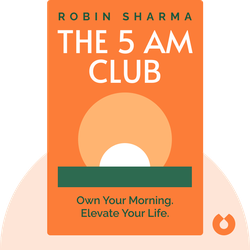Try Blinkist to get the key ideas from 7,000+ bestselling nonfiction titles and podcasts. Listen or read in just 15 minutes.
Start your free trial
Blink 3 of 8 - The 5 AM Club
by Robin Sharma

A Research Based Program for Strength Training, Body Building, and Complete Fitness in 12 Minutes a Week
Body by Science by Doug McGuff and John Little is a fitness book based on scientific research that challenges traditional exercise methods. The focus is on high-intensity strength training with fewer repetitions and greater intensity to achieve maximum results in less time.
Greece, 480 BC. The united forces of Athens and Sparta defeat the invading Persian army at the Battle of Marathon. Generals give a young courier named Pheidippides an important task: to deliver the good news back to the capital.
Elated, he sprints the 25 miles to Athens. It only takes him a few hours, and his run becomes legendary. We still remember it as the first marathon. Surely, someone as fit as Pheidippides must have lived a long, healthy life?
Unfortunately, no. As soon as he arrived, the young courier collapsed and died.
His fate tells us something really important about how the human body works. This lesson is that exercise, fitness, and health aren’t always connected. In the following blinks, you will learn what modern science tells us about fitness training, and why running marathons – like Pheidippides did – may not be the best thing for your overall health.
The key message here is: Not all physical activities result in a healthier body.
So, what does it mean to be healthy? Surely science would have an answer to such a basic question, wouldn’t it? Well, as it turns out, you can pore through hundreds of medical texts, and you’ll probably find hundreds of theories. Still, in general terms, being healthy means being free of disease and having a body that naturally balances its internal chemical processes.
Two of these processes are really critical. They are called catabolic and anabolic. Catabolic processes are all about breaking things down. Turning proteins into energy would be an example. Anabolic processes are the opposite. They’re all about building things up. This includes growing muscle or producing hormones.
A healthy body will balance its catabolic and anabolic activities.
There’s a common misconception that all forms of physical activity will keep a body healthy. Sadly, this isn’t true. Some activities will make you fitter, which is to say better at withstanding the pressure of physical challenges. But these activities won’t necessarily improve your overall health.
Let’s look at long-distance running, for example. It will certainly make you faster, but there are trade-offs. Runners can develop serious health issues. Their knees can get damaged, their spines can degenerate, their hearts can develop unhealthy rhythms. This is because long-distance running supercharges the build-up of some parts of the body. But, in return, it also speeds up the degradation of other organs. So, over time, you end up with an imbalance.
But there are things you can do to improve your body’s overall fitness; to maintain the balance of catabolic and anabolic processes. This is true exercise, and in the next blink, we’ll take a closer look at what it looks like.



Body by Science (2009) is a comprehensive guide to building muscle. This handbook is driven by data, and it offers a scientifically proven approach to sculpting a fitter, firmer body. All you’ll need is a few minutes a week.
Body by Science (2009) is a comprehensive guide to high-intensity training and its transformative effects on the body. Here's why this book is worth reading:
The fitness worlds misplaced focus on the cardiovascular system needs to be redirected to the muscular system.

It's highly addictive to get core insights on personally relevant topics without repetition or triviality. Added to that the apps ability to suggest kindred interests opens up a foundation of knowledge.
Great app. Good selection of book summaries you can read or listen to while commuting. Instead of scrolling through your social media news feed, this is a much better way to spend your spare time in my opinion.
Life changing. The concept of being able to grasp a book's main point in such a short time truly opens multiple opportunities to grow every area of your life at a faster rate.
Great app. Addicting. Perfect for wait times, morning coffee, evening before bed. Extremely well written, thorough, easy to use.
Try Blinkist to get the key ideas from 7,000+ bestselling nonfiction titles and podcasts. Listen or read in just 15 minutes.
Start your free trial
Blink 3 of 8 - The 5 AM Club
by Robin Sharma
What is the main message of Body by Science?
Body by Science provides a scientific approach to fitness, emphasizing intensity and efficiency in workouts.
How long does it take to read Body by Science?
The estimated reading time for Body by Science is several hours. The Blinkist summary can be read in just 15 minutes.
Is Body by Science a good book? Is it worth reading?
Body by Science is worth reading as it offers science-backed insights and a time-efficient workout method.
Who is the author of Body by Science?
The author of Body by Science is Doug McGuff and John Little.